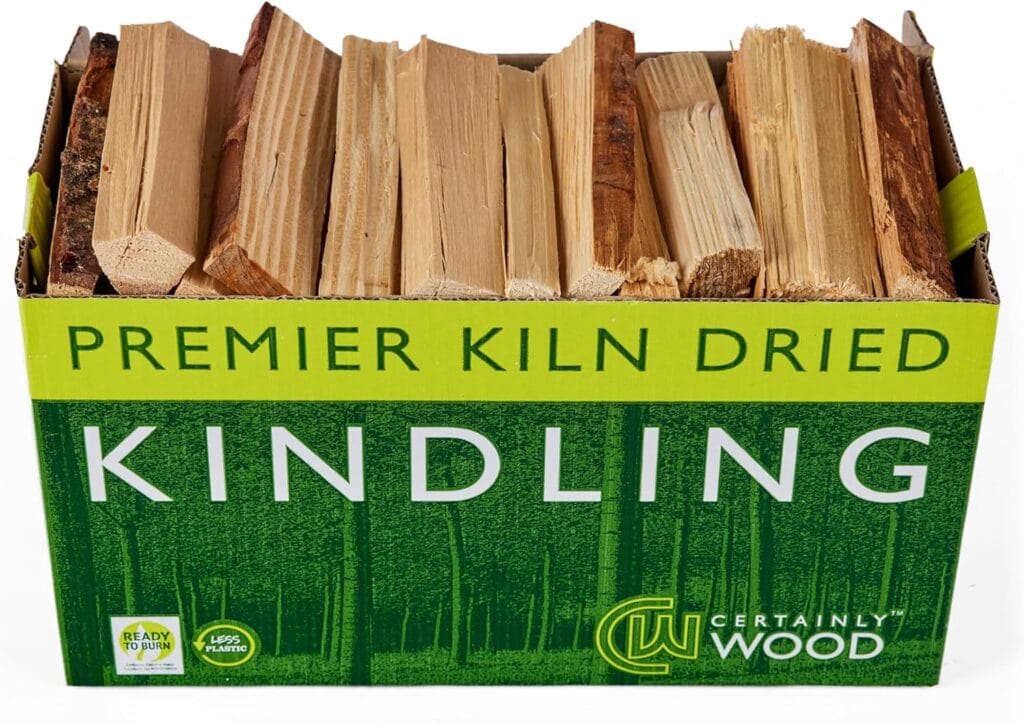Table of contents
Introduction: Best Firewood Types for Pizza Ovens and Fireplaces
If you’ve invested in a wood‑fired pizza oven or enjoy the comfort of a fireplace, the type of firewood you choose makes a big difference. The best firewood for pizza ovens isn’t just about heat — it also affects how evenly your oven cooks, how much smoke is produced, and even the flavour that infuses your food. Choosing the right pizza oven wood or fireplace logs can turn an ordinary fire into something much more efficient and enjoyable.

Recommended Option
Explore trusted pizza oven wood suppliers UK that deliver kiln-dried oak and fruitwood bundles direct to your home. These options provide reliable heat and the authentic, aroma-rich flavour that makes wood-fired cooking so popular.
Why Firewood Choice Matters
The right firewood keeps your oven or fireplace burning hotter, cleaner, and safer. It also gives you reliable warmth without the hassle of constant tending.
Types of Firewood
- Hardwoods such as oak, ash, and beech burn hotter and longer, making them ideal for consistent cooking and home heating.
- Fruitwoods like apple, cherry, and pear release sweet aromas that elevate pizza flavour and add character to indoor fires.
- Softwoods and damp logs often produce heavy smoke, waste energy, and may even release harmful fumes.
What This Guide Covers
- The best wood for pizza ovens and fireplaces, from oak and ash to apple and cherry.
- Firewood types to avoid, including resinous softwoods and treated wood.
- Where to source affordable logs, including how to find free local firewood.
- Storage tips to keep your logs seasoned, kiln‑dried, and ready to use.
Whether you’re making Neapolitan pizza outdoors or enjoying a roaring indoor fire, choosing the right firewood ensures every flame counts.
Why Wood Choice Matters
When you’re cooking in a wood-fired pizza oven or heating a room with a fireplace, the firewood you choose makes all the difference. The right pizza oven wood or fireplace logs won’t just provide heat — it also influences flavour, efficiency, and safety.
Heat Output and Consistency
- Hardwoods such as oak and ash burn hot and steady, keeping a pizza oven at the high temperatures needed for crisp bases and bubbling toppings.
- Softwoods burn quickly and unevenly, which means your oven temperature can fluctuate and spoil the cook.
Clean vs. Smoky Burn
- Kiln-dried or seasoned firewood burns cleanly, produces less smoke, and reduces soot build-up in chimneys and pizza ovens.
- Green or resin-heavy logs create too much smoke, encourage creosote build-up, and release unpleasant fumes.
For practical tips on cleaner burning and safety, check out DEFRA’s ‘Ready to Burn’ guide.
Flavour and Aroma for Cooking
- Fruitwoods such as apple, cherry, and olive give off sweet, subtle aromas that enhance Neapolitan-style pizza and other wood-fired dishes.
- Neutral hardwoods like oak and beech provide steady heat without changing the natural taste of food.
Environmental and Safety Considerations
- Choosing sustainably sourced, eco-friendly firewood for pizza ovens helps reduce your environmental footprint.
- Avoid burning treated, painted, or pallet wood, as these release harmful toxins and spoil food flavour.
Key Takeaway
The best firewood for pizza ovens and fireplaces balances consistent heat with low smoke and, when desired, natural flavour. By choosing the right firewood, you’ll get better results whether you’re cooking outdoors or relaxing by the fire indoors.
For more in-depth tips on properly seasoning and storing firewood, check out this guide: How to Season and Store Firewood Properly.
What to Look for in Good Firewood
Not all firewood performs the same. The quality of your logs directly affects how well your pizza oven or fireplace works. When choosing the best wood for pizza ovens and fireplaces, keep these factors in mind.
Moisture Content: Seasoned vs. Kiln-Dried
- Kiln-dried firewood: Dried in controlled kilns until moisture falls below 20%. This type burns hotter, cleaner, and is ready to use immediately in pizza ovens or log burners.
- Seasoned firewood: Air-dried for 12–24 months. It works well if stored correctly, though moisture levels can vary.
- Green or freshly cut logs: Too wet for efficient burning. They generate steam and smoke instead of producing steady heat.
Hardwood vs. Softwood
- Hardwoods (oak, ash, beech, hornbeam): Dense, long-burning, and ideal for pizza ovens and fireplaces. They deliver consistent heat with less smoke.
- Softwoods (pine, spruce, fir): Light and fast-burning, making them better suited for kindling. They lack the steady heat needed for cooking and can leave sticky resin.
- For cooking, hardwoods remain the best firewood for pizza ovens because they maintain the high temperatures needed for crisp bases and even cooking.
Log Size and Density
- Smaller, thin-cut logs: Ignite quickly and work best for firing up pizza ovens.
- Larger, denser logs: Burn longer and keep fireplaces glowing steadily through the evening.
- The most effective approach is a mix: small logs to start the fire and larger logs to maintain heat.
Safety Tip: What Not to Burn
- Avoid painted, varnished, or chemically treated wood — burning them releases harmful fumes.
- Stay clear of plywood, MDF, and pallet wood in pizza ovens, as they can spoil flavour and damage your oven.
Key Takeaway
Choosing kiln-dried hardwood logs in the right size provides the perfect balance of heat, flavour, and efficiency. Whether you’re cooking authentic pizza or warming your home, the right firewood guarantees reliable results.
Best Firewood for Pizza Ovens
Cooking authentic pizza isn’t just about the dough or toppings — the firewood you choose is just as important. The best firewood for pizza ovens provides steady, high heat and often adds subtle flavours that make food taste exceptional. Below are the top options when selecting the right pizza oven wood.
Oak
- A classic hardwood and one of the most reliable choices for pizza ovens.
- Burns hot and long with a consistent flame.
- Offers a neutral flavour that will not overpower ingredients.
- Widely available as kiln-dried oak logs for pizza ovens.
Ash
- Easy to split and light, making it practical for cooking.
- Produces even, reliable heat, perfect for maintaining the right pizza oven temperature.
- Known as one of the most versatile hardwoods for both ovens and fireplaces.
Beech
- A dense hardwood with high energy output.
- Burns cleanly with minimal smoke.
- Excellent for crisping pizza bases without leaving excess soot.
Fruitwoods (Apple, Cherry, Pear, Olive)
- Add sweet, subtle flavours that enhance Neapolitan-style pizzas.
- Create a gentle, aromatic smoke that infuses food naturally.
- Best used in combination with oak or ash for steady heat and balanced flavour.
Firewood to Avoid
- Resinous softwoods (pine, spruce, fir): create excessive smoke, encourage creosote build-up, and can leave a bitter aftertaste.
- Green or damp logs: high moisture content makes them inefficient, smoky, and unsuitable for cooking.
Key Takeaway
The best wood for pizza ovens is always dry, dense hardwood — ideally kiln-dried oak or a mix of oak and fruitwood. This ensures consistent heat, clean burning, and the delicious flavour that makes wood-fired cooking so popular.

Recommended Option
Choose a mix of kiln-dried oak logs and fruitwood bundles for restaurant-quality pizzas with authentic wood-fired flavour. This combination delivers dependable heat and that sought-after aroma-rich cooking experience.
Best Firewood for Fireplaces
A fireplace is about more than warmth — it creates a cosy and inviting atmosphere. The best firewood for fireplaces delivers steady heat, burns cleanly with minimal smoke, and can even add a subtle aroma that makes your living space feel more comfortable. Below are the top options when choosing high-quality firewood for fireplaces.
Hardwoods for Long, Steady Heat
- Oak: A classic hardwood that burns slowly and evenly, making it perfect for long evenings by the fire.
- Ash: Easy to split and light, produces reliable heat, and performs well even when slightly green.
- Hornbeam: A dense hardwood that provides intense, long-lasting heat, ideal for cold winter nights.
Aroma-Rich Firewood
- Apple: Adds a sweet, gentle fragrance that enhances the atmosphere.
- Cherry: Creates a mild, fruity aroma that makes the room feel warm and cosy.
- Both pair well with oak or ash for a balance of heat and character.
Budget-Friendly Choices
- Mixed hardwood logs: Widely available in bulk and usually more affordable.
- Provide good burning efficiency and are a practical option for everyday fireplace use.
Quick and Reliable Kindling
- Birch: Burns quickly and hot, excellent for starting fires.
- Softwood kindling (pine, spruce): Works well to get a fire going but is less suited for longer burns since it produces more smoke and soot.
Key Takeaway
The best wood for fireplaces is dry, seasoned hardwood that burns efficiently while adding warmth and character. Combining dense hardwoods with aroma-rich fruitwoods offers the perfect balance of heat and ambience.

Recommended Option
Choose a mixed hardwood log bundle or a fireplace starter kit to keep your firewood supply affordable, efficient, and ready for long, cosy nights.
Firewood Types to Avoid
Not every log is suitable for burning, and using the wrong firewood in your pizza oven or fireplace can lead to problems. The wrong choice often produces heavy smoke, damages your oven or chimney, and may even create health risks. To get the best results, avoid the following types of firewood.
Resinous Softwoods
- Pine, spruce, and fir contain high levels of sap and resin.
- These woods burn quickly, generate thick smoke, and cause dangerous creosote build-up in chimneys and pizza ovens.
- In cooking, resinous softwoods often leave pizzas with a harsh, bitter taste.
Painted, Treated, or Pallet Wood
- Frequently coated with varnish, paint, or chemicals.
- Burning this type of wood releases toxic fumes that are unsafe for cooking and indoor air quality.
- This wood should never be used in either pizza ovens or fireplaces.
Wet or Green Logs
- Freshly cut logs contain excessive moisture.
- They create steam and smoke rather than delivering strong, steady heat.
- Burning wet logs is inefficient, wastes energy, and increases the risk of chimney blockages.
Key Takeaway
For safe, clean, and efficient fires, always use kiln-dried hardwoods or well-seasoned logs. Selecting the right firewood not only protects your health but also keeps your pizza oven and fireplace working at their best.
Sourcing the Right Firewood
Finding reliable firewood for your pizza oven or fireplace does not need to be expensive. With the right approach, you can balance quality, cost, and sustainability while ensuring you always have the best firewood for pizza ovens and fireplaces ready to use.
Use the Free Firewood Finder Tool
- Start with our Find Free Firewood Near Me Tool to locate local, no-cost sources of logs.
- It is a quick and simple way to top up your supply of free local firewood without straining your budget.
If you’re looking to cut costs, check out our guide on finding free and cheap firewood near you.
Buy from Local Suppliers
- Many UK and US suppliers offer kiln-dried hardwood logs cut specifically for pizza ovens and fireplaces.
- Deliveries are often available in crates, bulk bags, or nets, allowing you to choose what suits your storage space and usage.
- Supporting local suppliers helps cut transport miles and reduces your carbon footprint.
Consider Bulk Buying
- Ordering in bulk — such as builders’ bags, crates, or pallets — lowers the cost per log and ensures a steady supply.
- Mixed hardwood bundles are usually the most cost-effective choice for regular fireplace use.
Eco-Friendly Alternatives
- Heat logs, briquettes, and wood pellets provide consistent heat while producing minimal smoke.
- Pellets are particularly useful for smaller or portable pizza ovens.
- Briquettes made from compressed sawdust or recycled wood are a sustainable option worth considering.
Key Takeaway
The smartest way to secure the best wood for pizza ovens and fireplaces is to combine free sources, local suppliers, and eco-friendly alternatives. This approach keeps costs down while ensuring quality and sustainability.

Recommended Option
Explore trusted pizza oven wood suppliers UK that deliver kiln-dried oak and fruitwood bundles direct to your home. These options provide reliable heat and the authentic, aroma-rich flavour that makes wood-fired cooking so popular.
Storage and Preparation Tips
Once you have sourced quality firewood, proper storage and preparation are essential. Storing your logs correctly ensures they stay dry, efficient, and safe to use in both pizza ovens and fireplaces. Good storage also helps you get the most from the best firewood for pizza ovens and fireplaces by protecting it from damp and mould.
Store in a Dry, Ventilated Rack
- Use a firewood rack or log store to lift logs off the ground and allow proper ventilation.
- Position your rack in a sunny, breezy area to speed up drying.
- Cover only the top with a tarp or roof and leave the sides open so air can circulate.
Seasoning Firewood
- Freshly cut logs require 12–24 months to season naturally before burning.
- Stack logs with gaps between rows to encourage airflow.
- Well-seasoned firewood feels lighter and often shows cracks on the ends.
Kiln-Dried Wood
- For logs that are ready to burn immediately, choose kiln-dried firewood.
- Kiln drying reduces moisture content to below 20%, ensuring hotter, cleaner, and more efficient burning. This makes it ideal for both pizza ovens and fireplaces.
Check Moisture Levels
- A moisture meter is an affordable tool to confirm logs are under 20% moisture.
- Burning dry wood reduces smoke, improves efficiency, and protects your pizza oven or chimney.
For more advice on equipment, explore our guide to the essential tools for cutting, splitting, and transporting firewood.
Key Takeaway
Dry, well-prepared firewood guarantees efficient heat, cleaner burning, and safer use. Whether kiln-dried or naturally seasoned, the right storage approach keeps your logs ready for pizza nights or cosy evenings by the fire.
Final Thoughts
The firewood you choose has a major impact — whether you are cooking in a pizza oven or enjoying a cosy night by the fire. The best firewood for pizza ovens delivers steady, high heat, burns cleanly, and can add that extra touch of flavour that makes wood-fired food unforgettable. Fireplaces follow the same principles: hardwoods burn slow and strong, while fruitwoods bring character and aroma.
Quick Recap
- Hardwoods such as oak, ash, and beech provide consistent heat and reliable performance.
- Fruitwoods like apple and cherry add sweet, rich flavour that is perfect for pizza and enhances the atmosphere indoors.
- Avoid resinous softwoods, treated wood, and damp logs — they are smoky, inefficient, and unsafe.
- Proper storage keeps logs dry and ready to burn whenever you need them.
Practical Tips
For cost-effective options, use our Find Free Firewood Near Me Tool to source local logs. To get the most from your fuel, explore kiln-dried vs. seasoned firewood or build a DIY firewood rack to keep your supply neat and dry.
Key Takeaway
Whether it is pizza night in the garden or a relaxing evening by the fire, the right firewood ensures every flame counts.





